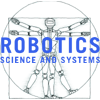TORO - News and Updates
2008-01-26
New version of TORO has been released that fixes some convergence problems
in 3D datasets (the distribution of the rotation error in 3D has changed).
2008-01-26
New version of TORO has been released that fixes some convergence problems
in 3D datasets (the distribution of the rotation error in 3D has changed).

(logo artwork by Christian Plagemann)
 |
Giorgio Grisetti, Cyrill Stachniss, Slawomir Grzonka, and Wolfram Burgard A Tree Parameterization for Efficiently Computing Maximum Likelihood Maps using Gradient Descent. Robotics: Science and Systems (RSS), Atlanta, GA, USA, 2007. paper (8 pg, pdf) |
 |
Grisetti Giorgio, Slawomir Grzonka, Cyrill Stachniss, Patrick Pfaff, and Wolfram Burgard Efficient Estimation of Accurate Maximum Likelihood Maps in 3D. In Proc. of the IEEE/RSJ International Conference on Intelligent Robots and Systems (IROS), 2007. paper (7 pg, pdf) -- WARNING: The math in this paper can cause convergence problems in 3D datasets resulting from the distribution of the rotation error. The implementation is fixed so that this issue does not arise. |